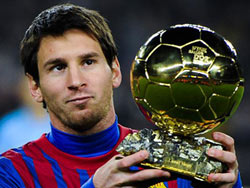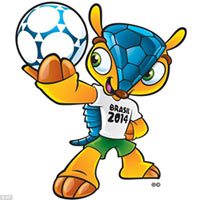The FIFA Ballon d’Or is the most prestigious soccer award given to the player that is considered to be the best in the previous soccer season. Ballon d’Or is French for “Golden Ball” and is awarded to the player who was voted as the best performer in the previous calendar year. The FIFA Ballon d’Or was originally known as just the Ballon d’Or and was created by France Football’s chief magazine writer, Gabriel Hanot in 1956.
The FIFA Ballon d’Or was originally made by Mellerio dits Meller, the prestigious jewelers founded in 1613, and continues to be made by the company. It is only fitting that The Mellerio dits Meller continue to manufacture the award as they have fashioned jewelry, silverware and ceremonial swords for royal courts all across Europe. CEO of Mellerio dits Meller, Francois Mellerio, says that the making of the Ballon d’Or is “a process that involves several craftsmen: a silversmith, repousseur, chaser, engraver, gilder and a polisher. All of them are highly valued and rare trades these days, and we are immensely proud to have created this legendary trophy.” The Ballon d’Or measures 31 centimeters high, 23 wide and 23 deep.
In the beginning, the Ballon d’Or was only voted on by journalists, and only European players on European teams were eligible for consideration. So players such as Maradona, who played for a European team but was not European himself, could not win the award. The first player to be awarded the Ballon d’Or was Stanley Matthews of Blackpool in 1956.
It was not until 1995 that the rules for the Ballon d’Or changed and allowed non-European players playing for European soccer clubs to win the Ballon d’Or. The same year that the rules for the soccer award changed the first non-European player, George Walsh of Milan, won the Ballon d’Or. Further amendments to the rules for awarding the Ballon d’Or were made in 2007 and dictated that any player in the world could win the award. Also in 2007, the number of journalists who were allowed to vote changed from 52 European based journalists to 96 journalists from all over the world. Each of the 96 journalists chooses their top five choices for the award. In 2010 the Ballon d’Or and the men’s FIFA World Player of the Year award were merged into one award, currently known as the FIFA Balloon d’Or.
Here is a complete listing of the Ballon d’Or & FIFA Balloon d’Or winners:
1956 – Stanly Matthews – Blackpool
1957 – Alfredo Di Stefano – Real Madrid
1958 – Raymond Kopa – Real Madrid
1959 – Alfredo Di Stefano – Real Madrid
1960 – Luis Suarez – Barcelona
1961 – Omar Sivori – Juventus
1962 – Josef Masopust – Dukla Prague
1963 – Lev Yashin – Dynamo Moscow
1964 – Denis Law – Manchester United
1965 – Eusebio – Benfica
1966 – Bobby Charlton – Manchester United
1967 – Florian Albert – Ferencvarosi
1968 – George Best – Manchester United
1969 – Gianni Rivera – Milan
1970 – Gerd Muller – Bayern Munich
1971 – Johan Cruyff – Barcelona
1972 – Franz Beckenbauer – Bayern Munich
1973 & 1974 – Johan Cruyff – Barcelona
1975 – Oleg Blokhin – Dynamo Kyiv
1976 – Franz Beckenbauer – Bayern Munich
1977 – Allan Simonsen – Borussia Monchengladbach
1978 & 1979 – Kevin Keegan – Hamburg
1980 & 1981 – Karl-Heinz Rummenigge – Bayern Munich
1982 – Paolo Rossi – Juventus
1983,1984 & 1985 – Michel Platini – Juventus
1986 – Igor Belanov – Dynamo Kyiv
1987 – Ruud Gullit – Milan
1988 & 1989 – Marco van Basten – Milan
1990 – Lothar Matthaus – Internazionale
1991 – Jean Pierre Papin – Marseille
1992 – Marco van Basten – Milan
1993 – Roberto Baggio – Juventus
1994 – Hristo Stoichkov – Barcelona
1995 – George Weah – Milan
1996 – Matthias Sammer – Borussia Dortmund
1997 – Ronaldo Luís Nazário – Internazionale
1998 – Zinedine Zidane – Juventus
1999 – Rivaldo – Barcelona
2000 – Luis Figo – Real Madrid
2001 – Michael Owen – Liverpool
2002 – Ronaldo Luís Nazário – Internazionale
2003 – Pavel Nedved – Juventus
2004 – Andriy Shevchenko – Milan
2005 – Ronaldinho – Barcelona
2006 – Fabio Cannavaro – Real Madrid
2007 – Kaka – Milan
2008 – Cristiano Ronaldo – Manchester United
2009, 2010, 2011 & 2012 – Lionel Messi – Barcelona

 The official mascot for the 2014 FIFA World Cup is Fuleco the Armadillo – As pictured to the left. The voting process for the official 2014 World Cup Mascot was a three month long campaign that was supported by Coca-Cola. Fuleco won the voting with 48% of the vote followed by Zuzeco with 31% of the vote and Amijubi with 21% of the vote, making Fuleco the unanimous winner. One of the most important themes of the 2014 FIFA World Cup is the importance of the environment and ecology. As an Armadillo, which is a vulnerable species, the name Fuleco is a combination of the words “futebol” and “ecologia”. This combination is intended to communicate the importance of behaving in an environmentally friendly manner. (For more information about Fuleco, visit http://mascot.fifa.com/about.php)
The official mascot for the 2014 FIFA World Cup is Fuleco the Armadillo – As pictured to the left. The voting process for the official 2014 World Cup Mascot was a three month long campaign that was supported by Coca-Cola. Fuleco won the voting with 48% of the vote followed by Zuzeco with 31% of the vote and Amijubi with 21% of the vote, making Fuleco the unanimous winner. One of the most important themes of the 2014 FIFA World Cup is the importance of the environment and ecology. As an Armadillo, which is a vulnerable species, the name Fuleco is a combination of the words “futebol” and “ecologia”. This combination is intended to communicate the importance of behaving in an environmentally friendly manner. (For more information about Fuleco, visit http://mascot.fifa.com/about.php)
 Detroit native Norman Koza, whose love for film got his experience from making his first feature.
Detroit native Norman Koza, whose love for film got his experience from making his first feature. BBA-Banking & Finance from University of Michigan. Lance has written 30 screenplays and directed 4 features.
BBA-Banking & Finance from University of Michigan. Lance has written 30 screenplays and directed 4 features. Email Us
Email Us